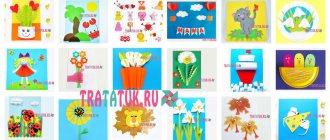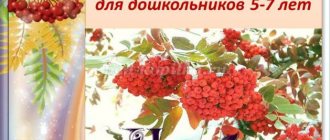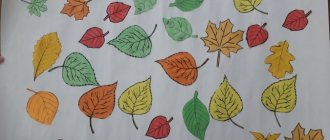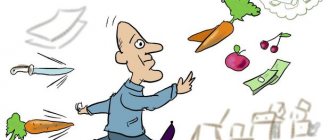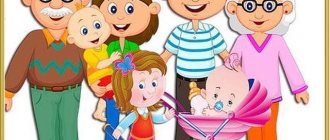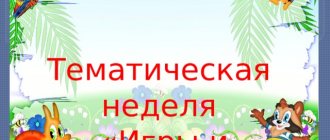Individual child development plan by area in the middle group
Plan for the individual development of a child by area
in the middle group
Plan of individual development of a child in the area of “Cognitive Development” section “Formation of a holistic picture of the world. Subject and social environment, acquaintance with nature" who scored low points based on the results of diagnostics of mastering the program of the educational process: Type of activity
The content of the work
Calendar dates
Topic: Immediate environment. Goal: to develop speech and auditory attention, thinking, memory; • stimulate cognitive processes.
D/I “Wonderful bag”.
Material: 10-15 items, different in purpose, characteristics and shape (models of vegetables, toy tools, cubes of building material, etc.). Task: 1) Choose any item from the bag. Name what this item is, what it is intended for (where it is used). 2) Describe it (what kind of object: hard, soft, what material is it made of, etc.).
October
Topic: Vegetables, fruits. Goal: Expand children's understanding of fruits and vegetables; continue to learn to distinguish them by appearance; establish cause-and-effect relationships using the example of fetal formation.
Didactic game “Harvest.” Material: baskets of different shapes (colors), subject pictures depicting vegetables and fruits (pear, plum, apple, tomato, cucumber, beet). Tasks: The teacher invites the child to look at the baskets and object pictures. Then he suggests collecting the harvest so that one basket contains fruits and the other contains vegetables.
November
Topic: family, family life, traditions. Goal: To clarify children’s knowledge about family ties; cultivate love and respect for your loved ones, a culture of behavior; develop speech.
D/I “Family Photography”. Material: a plot picture depicting a family (grandmother, grandfather, father, mother, brother, sister), or a photograph of a family (family holiday, hiking trip, etc.). Task: 1) Show the children in the picture (give them names). 2) Show the parents, what do their children call them? (Dad and Mom.) 3) What do you like to do as a family? 4) What is your favorite holiday? 5) Why? And so on.
December
Topic: Hometown, village, countryside. Goal: To consolidate children’s knowledge about the name of their hometown, village, village, and to introduce its sights. Find differences between city and countryside. Foster a sense of pride in your city.
D/I "City-Village".
Material: plot pictures depicting a city and a village.
Assignment: Questions. Look at the pictures. — What is the difference between a city and a village? — What is the name of the city in which we live? — What is the name of the street where you live? — Do you have a favorite place in your city or village where you like to go? Tell about him. Didactic exercise
“Hometown, village, village.” Material: illustrations of the sights of the city, village, village. Tasks: Questions. - Name the city and village in which you live. — What is the name of the street where you live? - Look at photographs of the sights of our city, village, village. - Do you know these places? etc.
December
Topic: Professions. Goal: To clarify and expand children’s ideas about people’s professions. Cultivate respect for people of all professions.
Didactic game “Who needs what?” Material: story pictures depicting people of various professions (teacher, cook, doctor, driver, policeman, fireman, tailor, teacher, hairdresser, builder). Pictures depicting professional supplies. Assignment: Questions: - Name who is shown in the pictures? - What does the doctor do? — What does a doctor need to work? — What should a doctor be like? - And the policeman? —What would you like to become when you grow up? And so on.
January
Topic: Wild and domestic animals. Goal: To consolidate children's knowledge about domestic and wild animals (what they look like, what they eat). Develop the ability to identify signs of similarity and difference and express them in speech.
Didactic game
"Hunter and Shepherd" Material: images of a shepherd and a hunter on flannelgraph. Subject pictures depicting domestic and wild animals (cow, goat, horse, pig, dog, chicken, cat, rabbit, sheep, hare, bear, wolf, fox, hedgehog, squirrel). Pictures showing what animals eat (fish, mushrooms, berries, mice, nuts, etc.). tasks: The teacher places a picture of a hunter on a flannelgraph on one side, and a shepherd on the other. Invites the child to name who it is. Asks clarifying questions. - Who is the hunter? -Who is the shepherd? Then he asks the child to look at object pictures depicting animals and place them so that all wild animals are next to the hunter, and domestic animals are next to the shepherd. After the child has done everything, the teacher asks to feed the animals.
February
Topic: trees, indoor plants, flowers. Goal: to teach children to classify: indoor plants, flowers, trees; differentiate by appearance.
D/I “Fill in the cells correctly.”
Material:
playing field (large three squares).
Subject pictures depicting trees (poplar, birch, maple, spruce, rowan); flowers (dandelion, chamomile, bell); indoor plants (aspidistra, begonia, primrose). Tasks:
The teacher offers the child a playing field (with symbols: tree, houseplant, meadow or wildflowers) and asks to arrange all the pictures into squares, according to their belongings.
March
Topic: humane attitude towards nature. Goal: to cultivate a humane attitude towards plants and animals; develop speech and auditory attention, thinking, memory
Conversation based on story pictures. Material: various plot pictures: children are preparing feeders, a child is feeding a dog, a child is picking flowers, a camping stop, etc. Tasks: The teacher asks you to carefully look at the pictures and tell who is doing the right thing and who is doing the wrong thing. Interested in whether the child likes to observe plants and animals. Why? And so on.
April
Individual child development plan in the area of “Speech development” section Speech development with children who scored low based on the results of diagnostics of mastering the program of the educational process: child’s FI
The content of the work
Calendar dates
Subject:
Lexicon.
Goal:
to form the grammatical structure of speech, the ability to compose different phrases, use pronouns in speech, select definitions for the subject, phenomena; agree adjectives with nouns in gender, number, case.
Didactic game "Finish the sentence." Contents of the diagnostic task: The teacher invites the child to play the game “Finish the sentence.” -I’ll start the sentence, and you, think about how you can finish it. - Sugar is sweet, and pepper... (bitter). - The road is wide, but the path... (narrow). - Plasticine is soft, and stone... (hard). - The stepmother is evil, and Cinderella ... - Karabas-Barabas is evil, and Papa Carlo ... etc.
October
Subject:
Child's vocabulary.
Goal:
to systematize the idea of the meaning of words. Activate the dictionary. Form the grammatical structure of speech, the ability to select words-names of qualities, actions, parts of objects. Understand and use antonym words.
Assignment “Tell about boys.”
Material: plot picture depicting two boys: one is clean, neat, cheerful, the second is sloppy, sad.
Tasks:
The teacher asks the child to look at a picture of two boys.
Then he organizes a conversation on the following questions: - What can you say about boys? Are they in the same mood? - One boy is cheerful, but what about the other? (Sad.)
- Is it good to be sloppy? - What should you do to be clean and tidy? - Which boy do you like? Why? And so on.
November
Subject:
Child's vocabulary.
Goal:
to form the grammatical structure of speech, the ability to compose different phrases, use pronouns in speech, select definitions for the subject, phenomena; agree adjectives with nouns in gender, number, case.
Game "Describe the object."
Material: various subject pictures.
Contents of the diagnostic task:
The teacher shows one picture at a time, for example:
a ball, a hat, a bucket, flowers.
Asks to answer the questions: - What is this?
(Ball.)
- What is he like?
(Red, big, airy.)
- What can you do with it?
(Play, roll on the floor, throw, kick.)
December
Subject:
The grammatical side of speech.
Goal:
learn to independently form new words (sugar - sugar bowl, bread - bread box, etc.); activate the generalizing word “dishes” in speech.
Didactic exercise “Setting the table.”
Material: tea set (for dolls), object pictures depicting food products (models).
Assignments:
The teacher suggests looking at the dishes and answering the questions: - How can you name all the objects?
(Draws attention to the tea set.) - Name famous pieces of utensils. — What products are needed to treat a person to tea? (Sugar, tea, crackers...)
- Which bowl should I put the sugar in?
(Into the sugar bowl.)
- And what about the crackers?
(Into the rusk bowl.)
Etc. - Arrange the dishes beautifully.
-Where is the teaspoon? (Next to the saucer or to the right of the saucer.)
Etc.
January
Subject:
The grammatical side of speech.
Goal:
Understands and uses prepositions in speech. Comprehends cause-and-effect relationships and composes complex, complex sentences. Correctly forms the plural form of nouns denoting baby animals.
D/I “Complete the sentence.”
Tasks:
The teacher asks the child to come up with the ending of the sentence: “Night has come and...” “Mom and I went to the store and bought...”.
"I like winter because... “We do exercises because”, etc. Didactic game “Hide and Seek”.
Material: sets of toy animals (bear cubs, kittens, hedgehogs, foxes) or object pictures with their image.
Tasks:
The teacher arranges the toys (lays out pictures) and asks the child to name groups of animals. - These are fox cubs. - These are hedgehogs. Etc. Then the teacher asks to remember all groups of animals and invites the child to close his eyes. The teacher removes one group of toys. After the child opens his eyes, the teacher asks to name who is missing (bear cubs, kittens, etc.).
February
Subject:
Coherent speech.
Goal:
teach consistently, compose a descriptive story about the toy according to the proposed plan.
Didactic game “Tell me about the toy.”
Material: a set of different toys: a car, a ball, a doll, a bunny, etc.
Tasks:
The teacher shows the toys and offers a sample story about one of them. Repeats it again, paying attention to the plan of the descriptive story. Then he offers to describe any of the toys according to the same plan.
March
Subject:
Coherent speech.
Goal:
to develop the skill of acting out an excerpt from a familiar fairy tale using a tabletop theater.
A dramatization of the fairy tale “The Cockerel and the Bean Seed.”
Tasks:
The teacher takes out a chicken, a cockerel, and a bean seed from a fairy chest. - What fairy tale do these heroes come from? - What happened to the cockerel? - Why do you think the cockerel choked? — Who did the chicken run to first for help? — What was the butter needed for? (A brief conversation is held about the fairy tale in order to remember its content.) Then the teacher invites the child to act out the fairy tale using a tabletop theater.
April
Subject:
Sound culture of speech
Goal:
to teach the child to isolate the first sound in a word.
Didactic exercise “Identify the first sound in a word.”
Assignments:
The teacher suggests playing with words. Asks the child to listen carefully as he identifies the first sound with his voice. OOO-la, AAA-stra, UUU-tka, etc. When repeating words, he asks to name the first sound.
May
Plan for the individual development of a child in the area of “Cognitive development” section “Formation of elementary mathematical concepts” with children who scored low points based on the results of diagnostics of mastering the program of the educational process Type of activity
The content of the work
Calendar dates
Topic: quantity, counting within 5. Goal: teach counting to 5; identify an item by set; establish equality between groups of objects of different sizes.
Didactic exercise “Count the cubes.”
Material: cubes (6-7 pieces each) of different sizes and colors. Contents of the diagnostic task: Instructions. -What do you see on the table? — How many cubes are there in total on the table? — How do the cubes differ from each other? - Count the cubes in order. -Which number is the yellow cube? (Red, etc.) - What color is the cube that is in fifth place? (Second, third.) - Show 3 red and 3 green cubes. - What can you say about them?
October
Topic: quantity, counting within 5. Goal: teach counting to 5; correlation of objects of two groups; determine: greater than, less than, equal to.
Didactic exercise “The butterflies have arrived.”
Material: the child has a two-line card; in the top row, butterflies (5 pieces) are glued at a certain distance.
There are butterflies (more than 5) on a tray nearby. Tasks:
How many butterflies are in the top row? Take the same number of butterflies from the tray and arrange them in the bottom row so that you can see that there are the same number of butterflies as there are butterflies in the top row (less than in the top row, more than in the top row).
November
Topic: Standards of magnitude. Goal: to develop children’s ability to compare three or more objects by size, to activate the words “higher, lower” in children’s speech.
Didactic exercise “Plant Christmas trees.”
Material: flat Christmas trees, different in height (2 pcs.).
Tasks:
Look, are all the Christmas trees the same in height? “Plant” the Christmas trees in descending (ascending) order, using the words “above” and “below”.
December
Topic: Magnitude. Goal: to develop children’s ability to compare three or more objects by size, to activate the words “narrow, wide, long, short” in children’s speech.
Didactic exercise “Compare tracks.”
Material: two tracks of different lengths and widths, a tennis ball.
Tasks:
The teacher suggests comparing the paths in length and width. - Show me the long track (short track). — What can you say about the width of the tracks? - Show me the wide path (narrow path). - Roll the ball along a narrow (wide) path; along the long (short) path.
January
Topic: geometric shapes. Goal: learn to distinguish and name geometric shapes; compare the shapes of objects with geometric patterns.
Didactic game “Find the same figures.”
Material: two sets (for the teacher and for the child) of shapes (circle, square, triangle, rectangle, ball, cube) of different sizes - large and small.
Tasks:
The teacher shows the child a figure and asks him to find the same one and name it.
Didactic game “Match the shape with the geometric figure.”
Material: subject pictures (plate, scarf, ball, glass, window, door) and geometric shapes (circle, square, ball, cylinder, rectangle, etc.).
Tasks:
The teacher asks to correlate the shape of objects with known geometric shapes: a plate is a circle, a scarf is a square, a ball is a sphere, a glass is a cylinder, a window, a door is a rectangle, etc.
February
Topic: orientation in space. Goal: to learn to determine the position of objects in space in relation to oneself, to distinguish between the right and left hand.
Didactic game "Order".
Material: set of toys: matryoshka, car, ball, pyramid.
Tasks:
The child sits on the carpet facing the teacher.
Arrange the toys as follows: the nesting doll is in front (relative to you), the car is behind, the ball is on the left, the pyramid is on the right. Didactic game “Name what you see” Tasks:
According to the teacher’s instructions, the child stands in a certain place in the group. Then the teacher asks the child to name the objects that are in front (right, left, behind) of him. Asks the child to show his right and left hands.
March
Topic: orientation in time. Goal: learn to identify parts of the day; meaning of words: yesterday, today, tomorrow; name the days of the week correctly.
Game exercise “When does this happen?”
Material: pictures depicting parts of the day, nursery rhymes, poems about different parts of the day.
Contents of the diagnostic task:
Instructions. Listen carefully to the nursery rhyme, determine the time of day and find the corresponding picture.
April
Plan for the individual development of a child in the field of “Artistic and Aesthetic Development” sections: modeling, drawing, appliqué, designing with children who scored low points based on the results of diagnostics of mastering the program of the educational process: Type of activity
The content of the work
Calendar dates
Topic: Subject drawing. Goal: the ability to correctly convey in a drawing the shape, structure of objects, arrangement of parts, ratio in size; connect objects with a single content; independently determine the content of a drawing on a given topic
Independent drawing based on the fairy tale “Kolobok”. Materials: sheets of paper, brushes, paints, illustrations for the fairy tale “Kolobok”. The child is invited to look at the illustrations for the fairy tale “Kolobok”. Questions: — What heroes are there in the fairy tale “Kolobok”? - Whom did Kolobok meet first (last)? —Which hero do you like best? Assignment: draw a picture for the fairy tale “Kolobok”
October
Topic: Drawing based on the Dymkovo toy. Goal: Children’s ability to create patterns based on arts and crafts.
Materials:
paper silhouette of a figurine of a lady, gouache, brush
Assignment:
The child is asked to decorate a figurine of a lady with a pattern from elements of Dymkovo painting (a Filimonov horse based on Filimonov painting)
november
Topic: Children’s level of mastery of sensory standards (colors) Purpose:
Didactic game “Name the color”.
Material:
a set of cards in 11 colors (white, black, red, yellow, blue, green, pink, blue, orange, brown, purple) A set of cards of different colors is laid out in front of the child.
Assignment:
name the color of each card. Show a blue (white, brown...) card
December
Topic: Modeling objects consisting of several parts. Goal: The ability to sculpt objects consisting of several parts, using the techniques of pulling, smoothing, pressing, pressing and smearing; use stack in work
Material:
plasticine, stack, modeling board
Task:
The child is asked to sculpt an object consisting of several parts. Note. In advance, you can suggest looking at samples of sculpted products.
January
Topic: Applique “Pattern of plant and geometric shapes.” Goal: Ability to create patterns from plant and geometric shapes in a circle
Materials:
6 green leaves, 6 yellow circles with a diameter of 3 cm, 6 red circles with a diameter of 1.5 cm, a plate template, glue
Task:
The child is asked to lay out and stick a pattern on the “plate” using plant and geometric shapes
February
Topic: Construction of a building according to a diagram. Goal: Ability to carry out construction according to the scheme
Material:
construction diagram, designer.
Questions:
-What detail lies at the base of the building?
— What part is placed on the base? -What is on top of the building? Task:
The child is asked to look at the construction diagram. build according to this diagram
March
Topic: Designing houses for fairy-tale characters. Goal: Ability to build different structures of the same object
Materials
: small construction set
Assignment:
The child is asked to build houses for fairy-tale characters: one house for Kolobok, another house for Little Bear (he lives on the first floor) and for Little Chanterelle (she lives on the second floor of this house)
April
Topic: Folding square and rectangular sheets in different ways (diagonally, in half, lengthwise, crosswise). Goal: Ability to fold square and rectangular sheets in different ways
Materials:
2 squares, 2 rectangles
Task:
The child is asked to: - fold a square sheet from corner to corner; - fold the square sheet in half; - fold the rectangular sheet in half lengthwise; - fold the rectangular sheet in half and crosswise
May
“Individual work with children during the day (from work experience)”
Goal: development of thinking, visual attention, develop the ability to classify objects according to essential characteristics, and generalize. Task: find in each group an object that does not fit with the others.
Didactic games are planned. The name and purpose of the game are written in the plan (if there is a card index, then the card number is indicated). In the field of cognitive activity, short conversations are planned for the morning with a group of children or with individual children on pre-planned topics and topics that arose on the initiative of the children. Conversations are accompanied by an examination of illustrations accessible to children.
Improve creativity, performing skills, and the ability to interact with other characters. To cultivate artistry, aesthetic feelings, to develop emotions, imagination, fantasy, the ability to transform, spiritual potential.
Didactic games are planned. The name and purpose of the game are written in the plan (if there is a card index, then the card number is indicated). In the field of cognitive activity, short conversations are planned for the morning with a group of children or with individual children on pre-planned topics and topics that arose on the initiative of the children. Conversations are accompanied by an examination of illustrations accessible to children.
Improve creativity, performing skills, and the ability to interact with other characters. To cultivate artistry, aesthetic feelings, to develop emotions, imagination, fantasy, the ability to transform, spiritual potential.
In order for parents to be aware of the life of the group and the successes of the children, on screens and stands in the locker room they place information about what a child should know and be able to do on the threshold of school (as an indicative, but not obligatory for each child), texts of poetic works, booklets and printouts of educational games.
To form the idea that an object can be divided into equal parts, that the whole is greater than the part. Learn to name parts, compare the whole and the part.
A feature of compensatory work in the older group is that sometimes children themselves can be involved in it as assistants. This contributes to the formation of responsibility, composure, and the emergence of a feeling of friendship and goodwill.
Expand ideas about your home country as a multinational state, public holidays, your home city and its attractions.
Goal: to teach children to distinguish between objects that are similar in purpose and similar in appearance, to help them remember their names; activate the appropriate vocabulary in children's speech.
Goal: to practice counting objects by the named number and memorizing it, to learn to find an equal number of toys.
The teacher invites the children to look at the diagram and find the path that leads to the fair. And there is a path that leads to the fair, on which all the geometric figures depicted near the basket remain crossed out (after all, these are magical geometric figures: they are shaped like images of the vegetables that Lena carries for sale).
Strengthen ideas about objects and phenomena of the surrounding reality. Develop the ability to observe, analyze, compare, and identify characteristic, essential features of objects and phenomena of the surrounding world.
In the afternoon, the teacher conducts individual work with children on the development of movements, drawing, cutting, designing, and correcting speech defects.
— Diagnostics and accounting of the level of development of labor skills of each child.
During walks, work is also done to develop the child’s speech: learning a nursery rhyme or a short poem, reinforcing a difficult sound to pronounce, etc. The teacher can recall with the children the words and melody of a song that they learned in a music lesson.
G.P. Tugusheva, A.E. Chistyakova “Experimental activities of children of middle and senior preschool age” Methodological manual. - St. Petersburg: Detstvo-Press, 2011.
The teacher reports that the harvest this year was so large that a lot of vegetables were brought to the fair. Some vegetables did not fit on the counter; they fell and rolled under it. The teacher suggests, by looking at the part of the vegetable that “peeks out” from under the counter, to recognize which vegetable has rolled, etc.
In the game, develop communication skills, emotional responsiveness to the feelings of people around you, imitation, creative imagination, activity, initiative, and independence. Learn to fairly evaluate your own actions and the actions of your comrades.
Items: 2 sets of wooden clothespins, different colors (red, blue, yellow, green - 3 of each color). Plastic bucket.
To form in children ideas about the Second World War, about the battles in Stalingrad, about the defenders of Stalingrad; cultivate love, a feeling of gratitude for WWII veterans, love for one’s hometown.
Ensure individualization of the educational process. All work with preschoolers is carried out on the basis of a careful study of the psychophysical characteristics, personal qualities and preferences of the children.
We build individual physical education work based on the age and individual characteristics of children. When drawing up a plan for individual work, the child’s motor interests are taken into account. Children are offered a variety of tasks and games.
